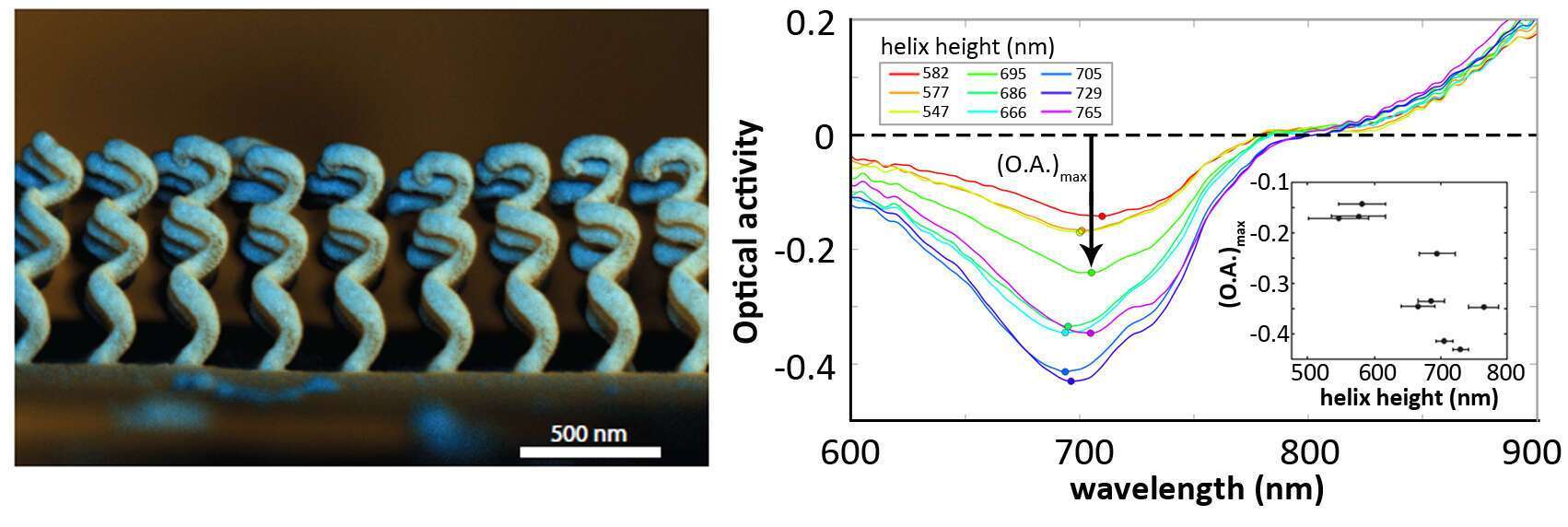
Optical Activity of Chiral Plasmonic Nanohelices
Chirality of three-dimensional structures, i.e. structures that cannot be superimposed on their mirror image, is a very common phenomenon in nature. This phenomenon has attracted increasing interest, as man-made chiral metamaterials have, for example, greatly improved biosensing [1]. Transmission measurements on chiral structures are known to differentiate between the way in which right- and left-circularly polarized light interact with these structures, an effect called circular dichroism. This effect has recently been demonstrated on metal helices in the micrometer wavelength regime [2] and on chirally configured metal nanodiscs and metal nanohelices in the nanometer wavelength regime [3, 4]. However, fabrication of complex three-dimensional nanostructures is a challenging process, in particular for visible light applications, where the corresponding structure sizes are on the nanoscale. Here, we show how electron beam induced deposition can be used to successfully fabricate periodic arrays of chiral core-shell (fused silica – gold) nanohelices (Fig. 1.a). We investigate circular dichroism at these nanohelices, where the core-shell allows for additional tunability of the optical properties.
In this work, we study arrays of core-shell nanohelices to determine the influence of helix height on the optical activity. Here, the optical activity (O.A.) is defined as O.A.= (TLCP – TRCP)/ (TRCP+TLCP) where TLCP(TRCP) is the transmission coefficient of left- (right-) handed circularly polarized light. Fig.2 shows the optical activity as a function of wavelength for nine different helix heights, revealing a clear dip at a wavelength of ~700nm in each curve. The relation between the maximum optical activity and the helix height is presented in the inset of fig. 1.b We experimentally observe a trend, where short helices show a smaller maximum optical activity than tall helices. Qualitative agreement is found with our theoretical predictions and those of Wegener and co-workers [2].

[1] E. Hendry, T. Carpy, J. Johnston, M. Popland, R. Mikhaylovskiy, A. Lapthorn, S. Kelly, L. Barron, N. Gadegaard and M. Kadodwala, Nat. Nanotechnol. 5, 783 (2010).
[2] J.K. Gansel, M.Thiel, M.S. Rill, M. Decker, K. Bade, V. Saile, G. von Freymann, S. Linden and M. Wegener, Science. 325, 1513 (2009).
[3] M. Hentschel, M. Schӓferling, T. Weiss, N. Liu and H. Giessen, Nano Letters. 12, 2542 (2011).
[4] J. G. Gibbs, A.G. Mark, S. Eslami and P.Fischer, Applied Physics Letters. 103, 213101 (2013).
hoogh@amolf.nl
Powered by Eventact EMS